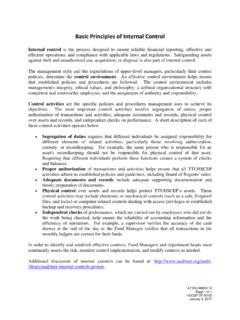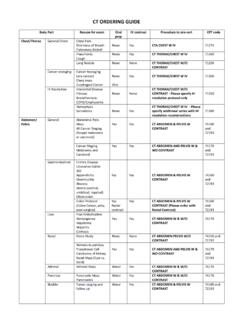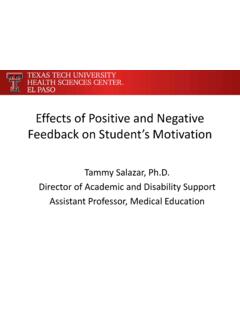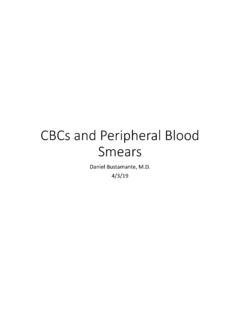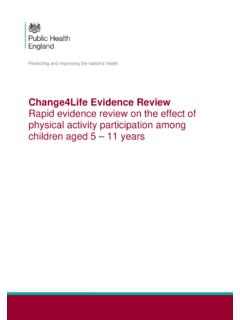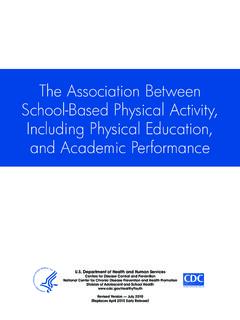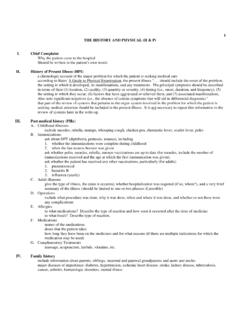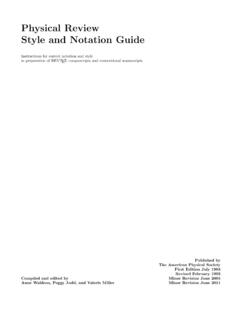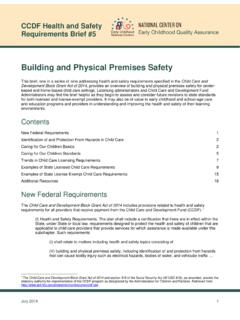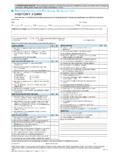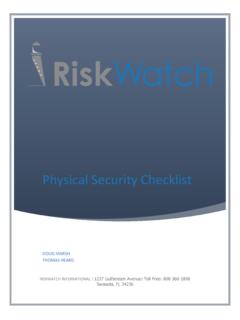Transcription of Pediatric History and Physical Examination
1 Pediatric History and Physical Pediatric History and Physical ExaminationExaminationHISTORY TAKINGHISTORY TAKING Formally introduce yourself by name and anticipated function in relation to the family and child The History usually is learned from the parent, the older child, or the caretaker of a sick child. During the interview, it is important to convey to the parent interest in the child as well as the illness. The parent is allowed to talk freely at first and to express concerns in his or her own words. The interviewer should look directly either at the parent or the child intermittently and not only at the writing InformationGeneral Information Identifying data include the date, name, age and birth date, sex, race, referral source if pertinent, relationship of the child referral source if pertinent, relationship of the child and informant indication of the mental state or reliability of the informant.
2 It frequently is helpful to include the ethnic or racial background, address, and telephone numbers of the informantsChief ComplaintChief Complaint Given in the informant's or patient's own words, the chief complaint is a brief statement of the reason why the patient was brought to be seen. It is not unusual that the stated complaint is not the true reason the child was brought for attention. Expanding the question of "Why did you bring him?" to "What concerns you?" allows the informant to focus on the complaint more accurately. Carefully phrased questions can elicit information without pryingHistory of Present IllnessHistory of Present Illness The details of the present illness are recorded in chronologic order.
3 For the sick child, it is helpful to begin: "The child was well until "X" number of days before this visit." This is followed by a daily documentation of events leading This is followed by a daily documentation of events leading up to the present time, including signs, symptoms, and treatment, if any. If the child is taking medicine, the amount being taken, the name of the medicine, the frequency of administration, and how well and how long it has been or is being taken are of Present IllnessHistory of Present Illness For the well child, a simple statement such as "No complaints" or "No illness" suffices.
4 A question about school attendance may be pertinent. If the past medical History is significant to the current illness, a brief summary is included. If information is obtained from old records, it should be noted here or may be recorded in the past medical historySick ContactsSick Contacts Parents Siblings Household members Household members What illness? URI etc Day Care AttendanceHISTORY FROM THE CHILDHISTORY FROM THE CHILD Even young children should be asked about their symptoms and their understanding of their problem. This also provides an opportunity to determine the interaction of the child with the parent.
5 For most adolescents, it is important to take part of the History from the adolescent alone after asking for his or her approval. Regardless of your own opinion, obtain the History objectively without any moral implications, starting with open-ended questions related to the initial complaint and then directing the questionsREVIEW OF SYSTEMSREVIEW OF SYSTEMS The review of systems serves as a checklist for pertinent information that might have been omitted. Questions concerning each system may be introduced with a question such as: "Are there any symptoms related to ..? Head( , injuries, headache) Head( , injuries, headache) Eyes( , visual changes, crossed or tendency to cross, discharge, redness, puffiness, injuries, glasses) Ears( , difficulty with hearing, pain, discharge, ear infections, myringotomy, ventilation tubes) Nose( , discharge, watery or purulent, difficulty in breathing through nose, epistaxis) Mouth and throat( , sore throat or tongue, difficulty in swallowing, dental defects) REVIEW OF SYSTEMSREVIEW OF SYSTEMS Neck( , swollen glands, masses, stiffness, symmetry)
6 Breasts( , lumps, pain, symmetry, nipple discharge, embarrassment) Lungs( , shortness of breath, ability to keep up with peers, cough with time of cough and character, hoarseness, cough with time of cough and character, hoarseness, wheezing, hemoptysis, pain in chest) Heart( , cyanosis, edema, heart murmurs or "heart trouble," pain over heart) Gastrointestinal( , appetite, nausea, vomiting with relation to feeding, amount, color, blood- or bile-stained, or projectile, bowel movements with number and character, abdominal pain or distention, jaundice) REVIEW OF SYSTEMSREVIEW OF SYSTEMS Genitourinary( , dysuria, hematuria, frequency, oliguria, character of urinary stream, enuresis, urethral or vaginal discharge, menstrual History , attitude toward menses and opposite sex, sores, pain, intercourse, venereal disease, abortions, birth control method) Extremities( weakness, deformities, difficulty in moving Extremities( weakness, deformities, difficulty in moving extremities or in walking, joint pains and swelling, muscle pains or cramps))
7 Neurologic( , headaches, fainting, dizziness, incoordination, seizures, numbness, tremors) Skin( , rashes, hives, itching, color change, hair and nail growth, color and distribution, easy bruising or bleeding) Psychiatric( , usual mood, nervousness, tension, drug use or abuse) PAST MEDICAL HISTORYPAST MEDICAL History Obtaining the past medical History serves not only to provide a record of data that may be significant either now or later to the well-being of the child, but also to provide evidence of children who are at risk for health or psychosocial problems. Past illnesses: infections, other illnesses/chronic illnesses-diagnoses and course, hospitalizations, surgeries, accidents, ER visits, medications/allergies, last medical check-upPRENATAL HISTORYPRENATAL History Age of the mother Health of the mother during this pregnancy.
8 Any infections (GBS, GC/chlamydia, hepatitis, syphilis, HIV, rubella, herpes) other illnesses, vaginal bleeding, toxemia, or care of animals, such as cats or other animal-borne diseases, animals, such as cats or other animal-borne diseases, substance abuse Number of previous pregnancies and their results Radiographs or medications taken during the pregnancy, Results of prenatal labs and other tests such as amniocentesis If the mother's weight gain has been excessive or insufficient, this also should be notedBIRTH HISTORYBIRTH History The duration of pregnancy, the ease or difficulty of labor, and the duration of labor may be important.
9 Especially if there is a question of developmental delay. The type of delivery (spontaneous, forceps-assisted, or cesarean section), type of anesthesia or analgesia used during cesarean section), type of anesthesia or analgesia used during delivery, presenting part (if known) are recorded. Note this child's birth order (if there have been multiple births) and birth weight Condition of the child at birth, resuscitation, APGAR score if knownNEONATAL HISTORYNEONATAL History Birth weight, length, head circumference Problems: jaundice, anemia, convulsions, respiratory problems, infections, feeding problems, excessive weight loss, birth injuries, dvsmorphic state, congenital anomalies loss, birth injuries, dvsmorphic state, congenital anomalies etc Age at discharge, NICU stay Was the baby discharged with the mother?
10 FEEDING HISTORYFEEDING History Breast- or bottle-fed - relevant until 1 year of age Type of formula used and the amount taken during a 24-hour period. Mother's initial reaction to her baby, the nature of bonding and eye-to-eye contact, and the patterns of crying, sleeping, and eye-to-eye contact, and the patterns of crying, sleeping, urinating, and defecating. Requirements for supplemental feeding, vomiting, regurgitation, colic, diarrhea, or other gastrointestinal or feeding problems should be noted. Ages at which solid foods were introduced and supplementation with vitamins or fluoride took place, as well as the age at which weaning FEEDING HISTORYFEEDING History The age at which baby foods, toddlers' foods, and table food were introduced, the response to these, and any evidence of food intolerance or vomiting.

